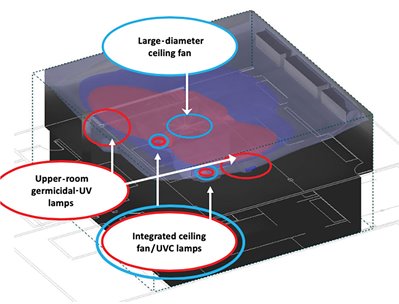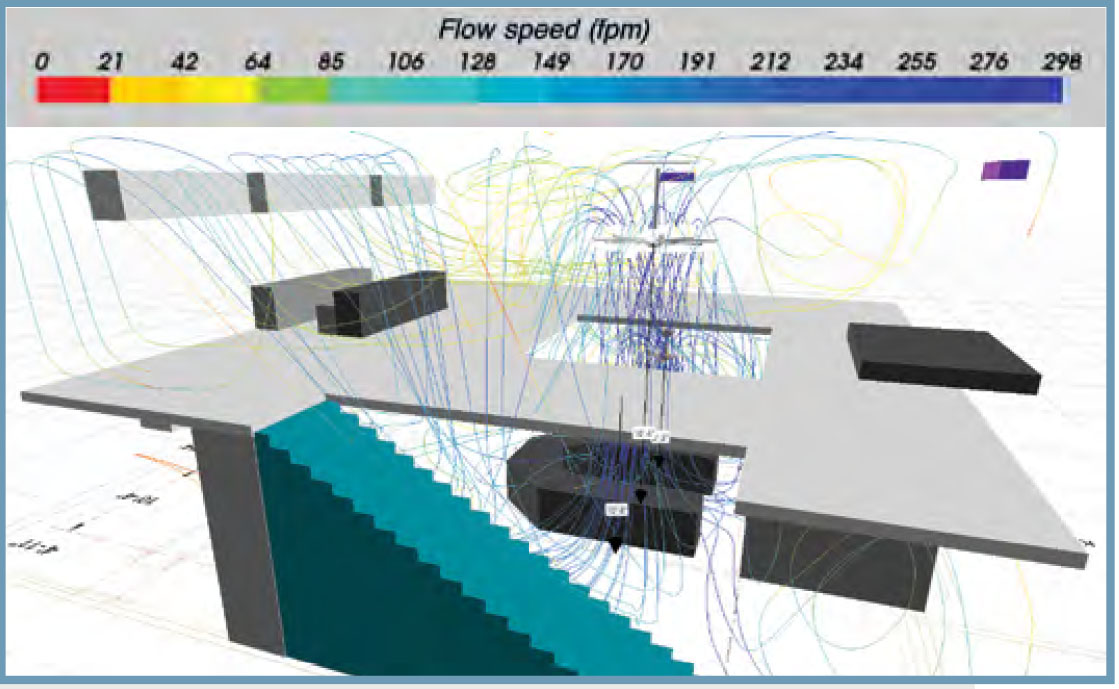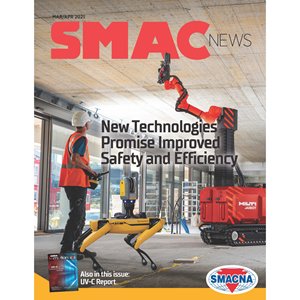Improving Upper-Room UV With Ceiling Fans

Lighting simulation showing upper-room-UV fluence rates (red = 10 uW/cm2, dark blue = 5 uW/cm2, light blue = 1 uW/cm2).
Studies show that, in spaces with limited air mixing, natural convection generated by heat gains from occupants and equipment at the floor level can reduce the effectiveness of upper-room/air UV systems. In such instances, the use of ceiling fans for air mixing has been shown to increase UV effectiveness by more than 60 percent.1
This is especially true in the case of facilities with high ceilings, where even HVAC systems with high airflow rates can struggle with air mixing and distribution. This issue is particularly problematic during the heating season, when the rate of illness among occupant populations tends to be the highest.

Computational-fluid-dynamics image tracing exposure of particles to upper-room UV-C lamps (purple rectangles in the upper right and center of the image) with the use of large- and small-diameter ceiling fans. Small-diameter ceiling fans integrated with UV-C lamps are not visible. The height of the large-diameter fan is 18 ft 4 in.; the heights of the small-diameter fans are 10 ft 4 in. and 9 ft 3 in.
With ceiling fans, the volume of air that is actively cleaned in the disinfection zone is more frequently circulated back to the occupant level and replaced in the disinfection zone with air that has a higher concentration of contaminants. With continual mixing of the disinfection-zone and occupant-breathing-zone air volumes, the effectiveness of the upper-room/air system is improved, increasing the effective air-change rate. This effect reduces the concentration of contaminants in the space without the need for a three- to six-time increase in outdoor-air-change rate. Once the space air is well-mixed, additional air turnovers are not likely to increase system effectiveness.2
David Rose is applications engineering manager for Big Ass Fans. He can be contacted at info@bigassfans.com.
References
1 Ko, G., First, M.W., & Burge, H.A. (2002). The characterization of upper-room ultraviolet germicidal irradiation in inactivating airborne microorganisms. Environmental Health
Perspectives, 110, 95-101.
2 Rudnick, S.N., McDevitt, J.J., Hunt, G.M., Stawnychy, M.T., Vincent, R.L., & Brickner, P.W. (2015). Influence of ceiling fan’s speed and direction on efficacy of upper-room, ultraviolet germicidal irradiation: Experimental. Building and Environment, 92, 756-763.
Published: April 30, 2021
IN THIS ISSUE
ARCHITECTURAL: Metal Press Brakes, Automation Lead to Architectural Improvements
Bipolar Ionization Spurs Interest as COVID-Fighting IAQ Solution
In Las Vegas, the tourism-dependent casino industry has been among the hardest hit by COVID-related shutdowns, capacity restrictions and the CDC’s recommendation to avoid nonessential travel.
Capitol Hill Update: SMACNA Endorses Major School Construction and Retrofit Legislation
Deteriorating Backlogs: Responding to a New COVID-19 Reality
When 2020 kicked off, the construction industry was flying high. With a steady flow of work and bidding opportunities, large infrastructure projects on the horizon and sureties offering a seemingly endless supply of bonding, most contractors were
HVAC: Now Serving Improved Restaurant Air Quality
Improving Upper-Room UV With Ceiling Fans
INDUSTRIAL: Putting on the Finishing Touch
New Technologies Promise Improved Safety and Efficiency
By now, many of us have seen the videos on the internet of industrial robots traversing warehouse obstacle courses like contestants on American Ninja Warrior.
RESIDENTIAL: HVAC Rebates Help “Frontline” Customers
Technology and the Future of Contracting Work
The Bidding Hack: 5 Ways to Increase Your Bid Win Rate
The Harder Work: Reputation Management and Trust Building
UV-C for HVAC Air and Surface Disinfection
The COVID-19 crisis is sparking interest in a long-established, yet not widely utilized, method of inactivating dangerous microbes.


